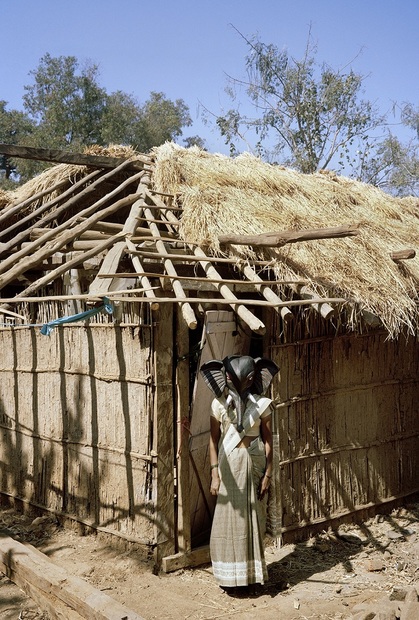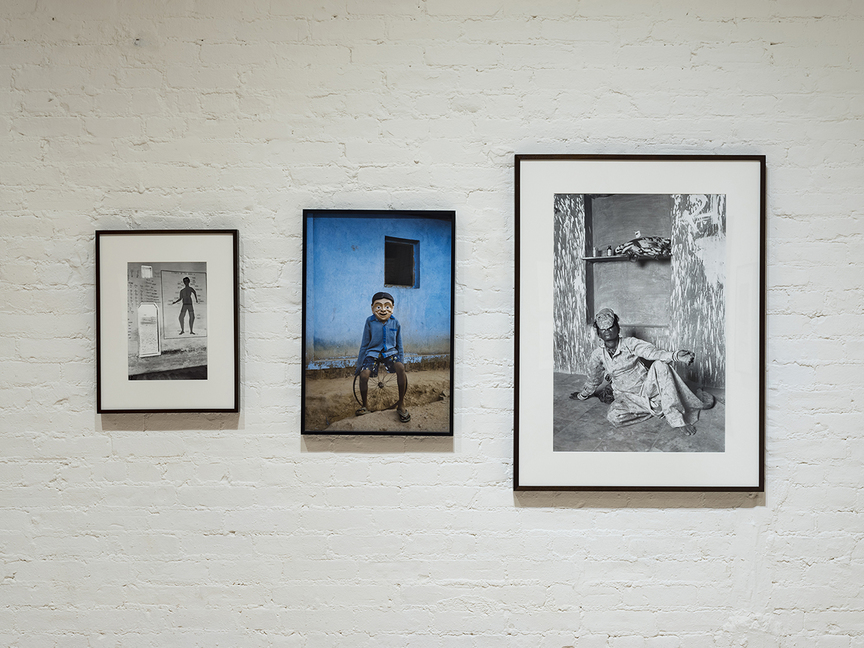-
From Current Issue
-
- Editor’s Letter Fire in the Heart
- Reviews I Gusti Ayu Kadek Murniasih
- Reviews 11th Seoul Mediacity Biennale: “One Escape at a Time”
- Dispatch Networked China
- One on One Monira Al Qadiri on Yukio Mishima
- Essays The rise of independent art spaces in pandemic-era Shanghai
- Features Tuan Andrew Nguyen
- Table of Contents
- Web Exclusives
- Archive
- Subscribe

R
E
V N
E
X
T
Installation view of GAURI GILL’s solo exhibition at MoMA PS1, New York, 2018. All images copyright the artist; courtesy the artist and Nature Morte, New Delhi.
The untitled color photographs that comprise Gauri Gill’s latest series, “Acts of Appearance” (2015– ), are starkly quotidian depictions of everyday village life that are attenuated by a touch of the surreal. The subjects of these photographs are members of an Adivasi (indigenous) community in the Jawhar district of the state of Maharashtra, located in the west of India. In Gill’s photographs, they are seen sitting in doctor’s offices and schools, leaning out of windows, strolling with their friends, engaging in the various actions—both staged and candid—that constitute daily life.
Each of these figures don a papier-mâché mask—of various creatures or even objects—made by the individuals in collaboration with the artist, specifically for the project. The Adivasis of Jawhar are eminent papier-mâché artisans, who create masks for religious ceremonies and celebrations. Shown in the context of otherwise banal activities, the masks take on a new kind of celebratory ethos, simultaneously animating the individuals in each of the photographs and highlighting the community’s status as a collective unit. In one of the images, a woman in an elephant mask and khaki-colored sari stands in front of the doorway of her thatched straw house; in two other prints, displayed next to one another, two men in bird masks stroll down a path while holding hands, and sit next to each other, as if in conversation. By obscuring their individual faces, Gill highlights the expressiveness of her subjects’ bodies and the relationships that bind these individuals to one another and the community at large. Whether they are at work, at play, or at rest, the subjects of these photographs are rendered as deeply embedded in their specific worlds—they are active agents in the environments around them.
Interspersed among “Acts of Appearance” were a selection of black-and-white photographs from two series, “Notes from the Desert” and “The Mark on the Wall,” both of which Gill began in 1999 in rural Rajasthan. The monochromatic palette of these images contrast starkly with the vibrant blue, orange and red hues of the homes and buildings in Jawhar village, and yet, many elements strike similar chords: a village mural in Rajasthan depicting the proper foods to eat in the event of diarrhea recalls the wheatpasted advertisements indicating various public health concerns in Jawhar. The resonances between the two demonstrate the interconnectedness of people within these rural communities and how public space is used as a site for communication and display. These photographs are also an insightful look into Gill’s photographic practice and her commitment to embedding herself within the communities with which she works as a collaborator, rather than a voyeur, which has afforded Gill the ability to capture intimate moments, such as women speaking to each other on porch steps, or a photo of a man daydreaming, that are charged with a captivatingly metaphysical vigor.
In recent years, political autonomy has often been, for better or for worse, synonymous with the idea of representation, emphasizing visibility as a means for the distribution of justice. The Adivasi communities of India are often marginalized in the political sphere, where despite quota policies and redistribution efforts, they are prevented from accessing adequate resources for education, healthcare, and the like. Gill’s photographic practice counters, to some extent, the failure of this type of representational politics by articulating the agency of marginalized groups to define their own subjectivities, portraying their rich and multifaceted lives. Here, the particular medium of the photograph, which has historically been deployed in ethnographic purposes as an exploitative means of documentation, becomes a vehicle for expression and definition. Some of the most charming photographs in “Acts of Appearance” are ones that are strikingly funny: in one, three men sit behind a desk in rabbit, owl, and monkey masks, respectively; in another, a trio of subjects, two human heads and an eagle, straddle a motorcycle. Referring to both performance as well as the process of doing, for these subjects, the “act” of appearing takes on the political valence of becoming—and viewers are extended the warm welcome of witnessing.
Gauri Gill’s solo exhibition is on view at MoMA PS1, New York, until September 3, 2018.
To read more of ArtAsiaPacific’s articles, visit our Digital Library.





